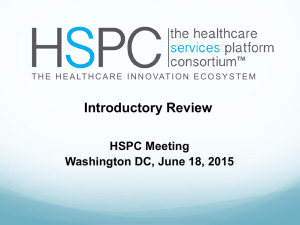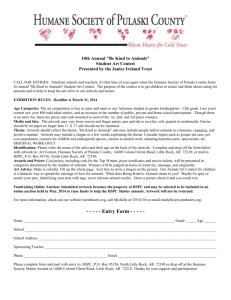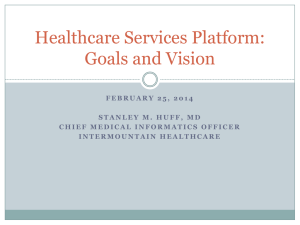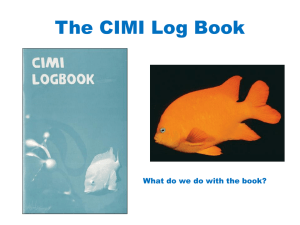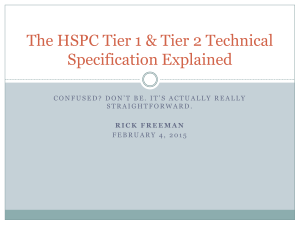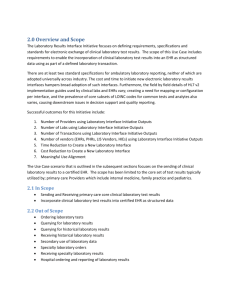“true” interoperability
advertisement
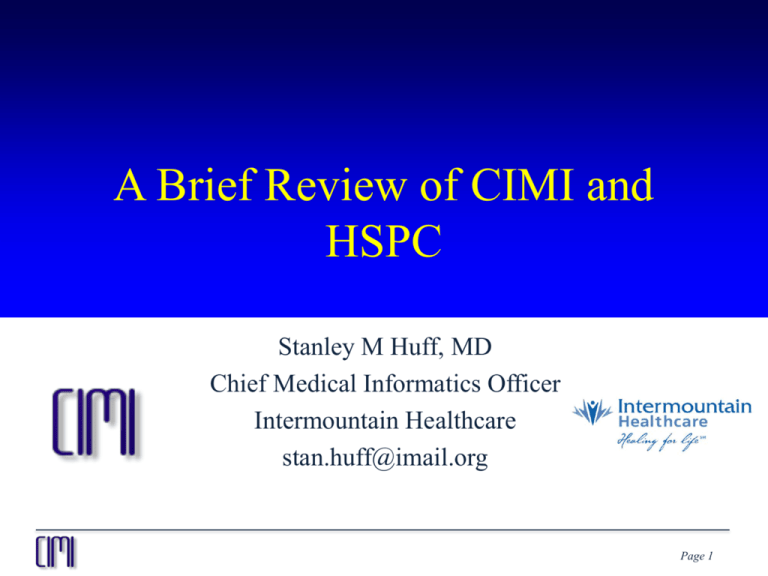
A Brief Review of CIMI and HSPC Stanley M Huff, MD Chief Medical Informatics Officer Intermountain Healthcare stan.huff@imail.org Page 1 Introduction • Stanley M. Huff, MD • Professor (Clinical) Department of Biomedical Informatics • Chief Informatics Officer, Intermountain Healthcare • • • • • Chair of the Board of HL7 Member of the ONC HIT Standards Committee Co-chair of the LOINC Committee Chair of the Board of HSPC Leader of CIMI Page 2 CIMI • The Clinical Information Modeling Initiative (CIMI) is a community of interest that is producing detailed clinical information models to enable interoperability of health care information systems • CIMI models are free for use for all purposes • See http://www.opencimi.org/ for more details Page 3 Graphic Presentation of a Detailed Clinical Model SystolicBPObs data SystolicBP 138 mmHg quals BodyLocation BodyLocation data Right Arm PatientPosition PatientPosition data Sitting #4 Clinical Information Modeling Initiative Mission Improve the interoperability of healthcare systems through shared implementable clinical information models. (A single curated collection.) Page 5 Clinical Information Modeling Initiative Goals • Create a shared repository of detailed clinical information models • Using an approved formalism – Archetype Definition Language (ADL) – Archetype Modeling Language (AML) • Based on a common set of base data types • With formal bindings of the models to standard coded terminologies • Repository is open to everyone and models are licensed free for use at no cost Page 6 Page 7 Access to the models • Browse and download models • CIMI models – http://www.clinicalelement.com/cimi-browser/#/ • Intermountain models – http://www.opencem.org/#/ #8 T H E H E A LT H C A R E I N N O VAT I O N E C O S Y S T E M An Opportunity to Foster Truly Interoperable Health Care Applications OUR MISSION Improve health by creating a vibrant, open ecosystem of interoperable applications OUR VISION Be a provider-led organization that accelerates the delivery of innovative healthcare applications that improve health and healthcare Standards Based Services - HIMSS FHIR Profiles from CIMI Models (uing standard terminology) http://smartplatforms.org/smart-on-fhir/ Like Google Maps… Apps that address specific focused problems… Provider-facing services App 1 App 2 Focused decision support Visualization Disease management Specialty workflows National Shared Services Genomic testing & CDS Pharmacogenomic screening CDC Ebola screening? CDC immunization forecaster Prior Authorization / Appropriateness EHR App 3 Like Facebook… Apps that enable data sharing… App 1 Next-gen Interoperability Population Health integration HIE integration Data capture for research Clinical Trial recruiting Quality Repositories EHR 1 EHR 2 EHR 3 Like ???? … Apps that empower patients / consumers… Apps as Prescriptions SMART Phone App Chronic disease management Pt-Provider Communication Remote monitoring Outcome capture & Clinical Effectiveness Monitoring EHR Pop Health HSPC Technology Assumptions (already decided) Services – FHIR Generate FHIR profiles from existing model content Data modeling CIMI models Terminology LOINC, SNOMED CT, RxNorm, HL7 tables EHR Integration – SMART 16 HSPC History HSPC was incorporated as a not-for-profit corporation on August 22, 2014 Meetings May 2013 Salt Lake City August 2013 in Phoenix January 2014 Salt Lake City May 2014 in Phoenix July 2014 Salt Lake (Technical modeling meeting) August 21-22 2014, Washington DC, hosted by IBM February 4-6, New Orleans, Louisiana, hosted by LSU June 17-19, Washington DC August 10-13, Salt Lake City September 28-30, Phoenix (tentative) 17 Essential Functions of the Consortium Select the standards for interoperable services Standards for models, terminology, security, authorization, context sharing, transport protocols, etc. Modeling: SNOMED, LOINC, RxNorm – FHIR Profiles – do it together Publish the models, and development instructions openly, licensed free-for-use Provide testing, conformance evaluation, and certification of software Gold Standard Reference Architecture and its Implementation We will work with an established company to provide this service Fees that off set the cost of certification will be charged to those who certify their software Implementation of the standard services by vendors against their database and infrastructure Everyone does not have to do every service There must be a core set of services that enable a marketplace 18 Other Functions of the Consortium Participation in “other” functions is optional for a given member Enable development “sandboxes” Could be provided by companies or universities Could be open source or for-profit Set up a vendor and provider neutral “App Store” Many companies already have their own app stores Vendor certification that a given application can be safely used in their system Accommodate small companies or individuals that won’t have their own app store Create a business framework to support collaborative development Pre-agree on IP, ownership, co-investment, allocation of revenue Try to avoid unique contracts for each development project Provide a way for people to invest (Venture capital) in HSPC technologies 19 Opportunities Quality and disease specific repositories Sharing of data for patient care Sharing of clinical decision support and other applications Patient engagement HSPC is about more than just data virtualization SOA Services Layers UI • Support common UI Standards • Provide services for imbedding application in existing EMR/EHR frameworks Orchestration of Services and Busines Layer • Implement a multi-layered services architecture (SOA) • Support common Decision Support models (BPMN2/Drools) • Support common workflow models (BPMN2) • Data and vocabulary transformation Services • Context management services • Master Data Management Services • Identity Management Services Data Virtualization • Support FHIR/Restful Services models that support launch and forget applications and applications that support a full SOA services stack • Deploy FHIR profiles in collaboration with Argonaut, the VA, Intermountain, Regenstrief, Mayo/ASU and LSU. 22 SOA Guiding Principles Three tiered services model Maintain atomic services that are consistent in performance and behavior Can be administered once in a framework Can be orchestrated under a true SOA governance Can be consumed by anyone implementing the HSPC reference architecture Can be addressed by synchronous and asynchronous service requests Are implementable out of the box Are supportable and documented to a standard Provide HSPC supported services as open source 23 Principles Not-for-profit entity There could be an associated for-profit entity some day Provider led Simple majority of providers on the Board of Directors All organizations will have equal influence and opportunity Intermountain and Harris will not be “special” Start small, be effective, and then grow We want to allow everyone that is interested to participate Allow diverse strategies and participants Open source and for-profit One person business up to multi-national corporations Healthcare providers and healthcare software developers Students and professional software engineers 24 Principles (continued) Initially, focus on the minimum set of standards and technology Increase options as we gain experience and success HSPC is not producing software (mostly) HSPC members or groups of members produce software HSPC may need to provide a reference implementation for purposes of certification No “central planning” by HSPC of app development Participants decide what they want to build and invest their own resources We DO need to agree about the minimum set of services that will enable a marketplace 25 Sample of Participants HL7 FHIR – Grahame Grieve Center for Medical Interoperability – Todd Cooper SMART – Josh Mandel RelayHealth – Arien Malec Cerner – David McCallie, Marc Overhage NLM – Clem McDonald Epic – Janet Campbell Infocare Healthcare – Herb White VA – Jonathan Nebeker, Paul Nichol Mayo Clinic – Cris Ross openEHR – Thomas Beale Clinical Architecture – Shaun Shakib Open Health Tools – David Carlson Cognitive Medical Systems – Doug Burke Harris – Vishal Agrawal Intermountain Healthcare IBM – Jeff Rogers, Dennis Leahy Systems Made Simple – Viet Nguyen ASU – Aziz Boxwalla, Robert Greenes LSU – Frank Opelka, Wayne Wilbright, John Couk Regenstrief Institute – Douglas Martin 26 Key Organizational Relationships (not exhaustive) Argonauts Don’t know for sure A call is planned to discuss the relationship Work together on HIMSS demonstrations? Work together to create industry wide consensus for profiles to be used for “true” interoperability? HL7 HSPC will use HL7 FHIR for data services CIMI plans to become a part of HL7 HSPC will use HL7 as the forum for creating industry wide agreement about: Detailed profiles for true interoperability Consensus of professional and clinical bodies about data that needs to be collected and shared (workflow or process interoperability) SMART HSPC will use SMART as a EHR integration strategy HSPC will work together with SMART on all activities of mutual interest We will create a written document (MOU?) to describe the relationship between the two organizations Center for Medical Interoperability Work for support of CIMI and HSPC as part of C4MI technical programs Possible activities Host a vendor and provider neutral app store Create a reference implementation of HSPC services Host a development sandbox Logistic support Meetings, websites, publicity Host a model repository (and other knowledge artifacts) Support online terminology services Tool development Conformance testing and certification HSPC Internet Sites Wiki: https://healthservices.atlassian.net/wiki/display/HSPC/ Healthcare+Services+Platform+Consortium Website: http://hspconsortium.org/#/ 32 Q&A
